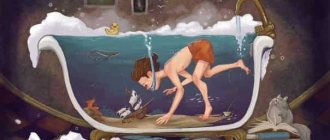Theoretical idea of imagination, its types and functions
Imagination is also connected with the implementation of our volitional actions. Thus, imagination is present in any type of our work activity, since before creating anything, it is necessary to have an idea of what we are creating. Moreover, the further we move away from mechanical labor and approach creative activity, the more the importance of our imagination increases.
The activity of imagination is associated with the work of the cerebral cortex. Often this cognitive process correlates primarily with the activity of the right hemisphere. However, it should be recognized that for the formation of imaginative images, a systemic interaction of both hemispheres is necessary, each of which specializes in performing certain functions: the right hemisphere ensures the integrity of representation, proportionality and compositional unity, it is customary to see the material substrate of aesthetic feelings in it; left - makes it possible to verbalize the representation, its detailed description, i.e. supports the unity of image and word, imagination and verbal expression [19].
It is generally accepted that the physiological basis of imagination is the actualization of neural connections, their disintegration, regrouping and unification into new systems. In this way, images arise that do not coincide with previous experience, but are not divorced from it. The complexity, unpredictability of imagination, its connection with emotions give reason to assume that its physiological mechanisms are associated not only with the cortex, but also with deeper structures of the brain.
What are the mechanisms for processing ideas into imaginary images? Images that arise in the process of imagination cannot arise out of nothing. The process of creating imaginary images from impressions received by a person from reality can occur in various forms. Research by psychologists has identified several ways to create images of the imagination:
1. Agglutination is an elementary form of image synthesis, consisting of combining various qualities and parts of objects that are often incompatible in everyday life (mermaid, centaur).
2. Hyperbolization - increasing or decreasing an object (giant, gnome), changing the number of its parts (three-headed dragon).
3. Sharpening, emphasizing and strengthening individual features of an object (caricature, caricature).
4. Schematization of presentation, smoothing out differences, emphasizing the similarities of several objects.
5. Typification - highlighting the essential, reproduced in homogeneous facts and situations of the same type, the embodiment of these essential features in a specific image [27].
It should also be noted that imagination, due to the characteristics of the physiological systems responsible for it, is to a certain extent associated with the regulation of organic processes and movement. Imagination influences many organic processes: the functioning of the glands, the activity of internal organs, metabolism in the body, etc. For example, it is well known that the idea of a delicious dinner causes us to salivate profusely, and by instilling in a person the idea of a burn, one can cause real signs of “ burn" on the skin.
Thus, we can conclude that imagination plays a significant role both in the regulation of the processes of the human body and in the regulation of its motivated behavior.
There are different types of imagination. The basis for distinguishing types of imagination may be: the degree of subjective control, the degree of uniqueness of the image, features of the subject of representation, etc.
Otvetnye_otvety / My ready answers / Done / 46 Imagination
Question 46. Definition, types, functions of imagination. The role of imagination in solving cognitive and personality problems. Development of imagination. Imagination and creativity.
Imagination
- this is the mental process of creating new images, ideas and thoughts based on existing experience, by restructuring a person’s ideas.
Imagination
is closely connected with all other cognitive processes and occupies a special place in human cognitive activity. Thanks to this process, a person can anticipate the course of events, foresee the results of his actions and actions. It allows you to create behavior programs in situations characterized by uncertainty.
From a physiological point of view, imagination is the process of formation of new systems of temporary connections as a result of complex analytical and synthetic activity of the brain.
In the process of imagination, systems of temporary nerve connections seem to disintegrate and unite into new complexes, groups of nerve cells are connected in a new way.
The physiological mechanisms of imagination are located in the cortex and deeper parts of the brain.
Imagination
- this is the process of mental transformation of reality, the ability to construct new holistic images of reality by processing the content of existing practical, sensory, intellectual and emotional-semantic experience.
Types of imagination
By subject – emotional, figurative, verbal-logical
According to the content of work - artistic, technical
By mode of activity - active and passive, intentional and unintentional
By the nature of the images - abstract and concrete
According to the results, it is reconstructive (mental reproduction of images of objects that actually exist) and creative (creation of images of objects that do not currently exist).
Types of imagination:
- active -
when a person, through an effort of will, evokes appropriate images in himself. Active imagination is a creative, recreating phenomenon. Creative active imagination arises as a result of work, independently creates images that are expressed in original and valuable products of activity. This is the basis of any creativity;
- passive -
when images arise by themselves, do not depend on desires and will and are not brought to life.
Passive imagination is:
-
involuntary imagination
.
The simplest form of imagination is those images that arise without special intention or effort on our part (floating clouds, reading an interesting book). Any interesting, exciting teaching usually evokes a vivid involuntary imagination. One type of involuntary imagination is dreams
. N.M. Sechenov believed that dreams are an unprecedented combination of experienced impressions.
-
voluntary imagination
manifests itself in cases where new images or ideas arise as a result of a person’s special intention to imagine something specific, specific.
Among the various types and forms of voluntary imagination, one can distinguish reconstructive imagination, creative imagination and dream.
Recreating imagination manifests itself when a person needs to recreate a representation of an object that matches its description as fully as possible. For example, when reading books, we imagine heroes, events, etc. Creative imagination is characterized by the fact that a person transforms ideas and creates new ones not according to an existing model, but by independently outlining the contours of the created image and choosing the necessary materials for it. Creative imagination, like recreating, is closely related to memory, since in all cases of its manifestation a person uses his previous experience. A dream is a type of imagination that involves the independent creation of new images. At the same time, a dream has a number of differences from creative imagination. 1) in a dream a person always recreates the image of what he wants, but not always in creativity; 2) a dream is a process of imagination that is not included in creative activity, i.e. not immediately and directly providing an objective product in the form of a work of art, a scientific discovery, etc. 3) a dream is always aimed at future activities, i.e. A dream is an imagination aimed at a desired future.
Functions of the imagination.
In human life, imagination performs a number of specific functions. First
one of them is to represent reality in images and be able to use them when solving problems.
This function of imagination is connected with thinking and is organically included in it. The second
function of imagination is to regulate emotional states.
With the help of his imagination, a person is able to at least partially satisfy many needs and relieve the tension generated by them. This vital function is especially emphasized and developed in psychoanalysis. The third
function of imagination is associated with its participation in the voluntary regulation of cognitive processes and human states, in particular perception, attention, memory, speech, and emotions.
With the help of skillfully evoked images, a person can pay attention to the necessary events. Through images, he gains the opportunity to control perceptions, memories, and statements. The fourth
function of imagination is the formation of an internal plan of action - the ability to carry them out in the mind, manipulating images.
Finally, the fifth
function is planning and programming activities, drawing up such programs, assessing their correctness, and the implementation process. With the help of imagination, we can control many psychophysiological states of the body and tune it to upcoming activities. There are also known facts indicating that with the help of imagination, purely by will, a person can influence organic processes: change the rhythm of breathing, pulse rate, blood pressure, body temperature.
Imagination has the following functions
(as defined by R. S. Nemov):
— representation of reality
in images;
— emotional regulation
states;
-voluntary regulation of cognitive processes and human states:
— formation of internal
action plan;
— planning and programming
activities;
— psychophysiological management
state of the body.
The role of imagination in solving cognitive and personality problems.
Imagination is closely related to thinking:
- like thinking, it allows you to foresee the future;
- imagination and thinking arise in a problematic situation;
— imagination and thinking are motivated by the needs of the individual;
- in the process of activity, imagination appears in unity with thinking;
— the basis of imagination is the ability to choose an image; thinking is based on the possibility of a new combination of concepts.
The main purpose of fantasy is to present an alternative to reality. As such, fantasy serves two main purposes:
- it stimulates creativity, allowing you to create something that does not exist (yet), and
- it acts as a balancing mechanism of the soul, offering the individual a means of self-help to achieve emotional balance (self-healing). Fantasy is also used for clinical purposes; the results of projective psychological tests and techniques are based on fantasy projections (as is the case in the TAT). In addition, in various psychotherapeutic approaches, fantasy is assigned the role of an exploratory or therapeutic tool.
Development of imagination
It is very difficult to determine any specific age limits that characterize the dynamics of imagination development. There are examples of extremely early development of imagination. For example, Mozart began composing music at the age of four, Repin and Serov could draw well at the age of six. On the other hand, the late development of imagination does not mean that this process will be at a low level in more mature years. History knows of cases where great people, for example Einstein, were not distinguished by a developed imagination in childhood, but over time they began to be talked about as geniuses.
Despite the difficulty of determining the stages of development of imagination in humans, certain patterns in its formation can be identified. Thus, the first manifestations of imagination are closely related to the process of perception. For example, children aged one and a half years are not yet able to listen to even the simplest stories or fairy tales; they are constantly distracted or fall asleep, but listen with pleasure to stories about what they themselves have experienced. This phenomenon clearly shows the connection between imagination and perception. A child listens to a story about his experiences because he clearly imagines what is being said. The connection between perception and imagination continues at the next stage of development, when the child begins to process received impressions in his games, modifying previously perceived objects in his imagination. The chair turns into a cave or an airplane, the box into a car. However, it should be noted that the first images of a child’s imagination are always associated with activity. The child does not dream, but embodies the processed image in his activities, even though this activity is a game.
An important stage in the development of imagination is associated with the age when a child masters speech. Speech allows the child to include in the imagination not only specific images, but also more abstract ideas and concepts. Moreover, speech allows the child to move from expressing images of imagination in activity to their direct expression in speech.
The stage of mastering speech is accompanied by an increase in practical experience and the development of attention, which allows the child to more easily identify individual parts of an object, which he already perceives as independent and with which he increasingly operates in his imagination. However, the synthesis occurs with significant distortions of reality. Due to the lack of sufficient experience and insufficient critical thinking, the child cannot create an image that is close to reality. The main feature of this stage is the involuntary nature of the emergence of imagination. Most often, images of imagination are formed in a child of this age involuntarily, in accordance with the situation in which he finds himself.
The next stage in the development of imagination is associated with the emergence of its active forms. At this stage, the process of imagination becomes voluntary. The emergence of active forms of imagination is initially associated with stimulating initiative on the part of an adult. For example, when an adult asks a child to do something (draw a tree, build a house out of cubes, etc.), he activates the imagination process. In order to fulfill the request of an adult, the child must first create, or recreate, a certain image in his imagination. Moreover, this process of imagination, by its nature, is already voluntary, since the child tries to control it. Later, the child begins to use his own imagination without any adult participation. This leap in the development of imagination is reflected, first of all, in the nature of the child’s games. They become focused and story-driven. The things surrounding the child become not just stimuli for the development of objective activity, but act as material for the embodiment of images of his imagination. A child at the age of four or five begins to draw, build, sculpt, rearrange things and combine them in accordance with his plan.
Another major shift in imagination occurs during school age. The need to understand educational material determines the activation of the process of recreating imagination. In order to assimilate the knowledge that is given at school, the child actively uses his imagination, which causes the progressive development of the ability to process images of perception into images of imagination.
Another reason for the rapid development of imagination during school years is that during the learning process the child actively acquires new and diverse ideas about objects and phenomena of the real world. These ideas serve as a necessary basis for imagination and stimulate the student’s creative activity.
The degree of development of imagination is characterized by the vividness of images and the depth with which the data of past experience is processed, as well as the novelty and meaningfulness of the results of this processing. The strength and vividness of imagination is easily assessed when the product of imagination is implausible and bizarre images, for example, among the authors of fairy tales. Poor development of imagination is expressed in a low level of processing of ideas. Weak imagination entails difficulties in solving mental problems that require the ability to visualize a specific situation. With an insufficient level of imagination development, a rich and emotionally diverse life is impossible.
People differ most clearly in the degree of vividness of their imagination. If we assume that there is a corresponding scale, then at one pole there will be people with extremely high levels of vividness of the images of the imagination, which they experience as visions, and at the other pole there will be people with extremely pale ideas. As a rule, we find a high level of imagination in people engaged in creative work - writers, artists, musicians, scientists.
Significant differences between people are revealed regarding the nature of the dominant type of imagination. Most often there are people with a predominance of visual, auditory or motor images of the imagination. But there are people who have a high development of all or most types of imagination. These people can be classified as the so-called mixed type. Belonging to one or another type of imagination very significantly affects the individual psychological characteristics of a person. For example, people of the auditory or motor type very often dramatize the situation in their thoughts, imagining a non-existent opponent.
The development of imagination in the human race, considered historically, follows the same path as that of the individual. Vico, whose name is well worth mentioning here because he was the first to see how myths can be used for the study of the imagination, divided the historical path of mankind into three successive periods: divine or theocratic, heroic or fabulous, human or historical in the proper sense; and after one such cycle has passed, a new one begins
—
vigorous activity (D. in general) stimulates the development of imagination
— development of various types of creative activities and scientific activities
-use of special techniques for creating new products of imagination as solutions to problems - agglutination, typification, hyperbolization, schematypization
- agglutination (from lat.
agglutinatio - gluing) - combining individual parts or different objects into one image;
- emphasis, sharpening -
emphasizing some detail in the created image, highlighting a part;
- hyperbolization -
displacement of an object, change in the number of its parts, reduction or increase in its size;
— schematization —
highlighting the characteristic that is repeated in homogeneous phenomena and reflecting it in a specific image.
- typing -
highlighting the similarities of objects, smoothing out their differences;
- active connection of feelings and emotions.
Imagination and creativity.
The leading connection is the dependence of imagination on creativity: imagination is formed in the process of creative activity. The imagination, necessary for the transformation of reality and creative activity, was formed in the process of this creative activity. The development of imagination occurred as more and more perfect products of imagination were created.
Imagination plays a particularly important role in scientific and artistic creativity.
Creativity without the active participation of imagination is generally impossible. Imagination allows a scientist to build hypotheses, mentally imagine and perform scientific experiments, search for and find non-trivial solutions to problems. Imagination plays an important role in the early stages of solving a scientific problem and often leads to remarkable insights.
The study of the role of imagination in the processes of scientific and technical creativity is carried out by specialists in the psychology of scientific creativity.
Creativity is closely related to all mental processes, including imagination. The degree of development of imagination and its characteristics are no less important for creativity than, say, the degree of development of thinking. The psychology of creativity manifests itself in all its specific types: inventive, scientific, literary, artistic, etc. What factors determine the possibility of human creativity? 1) human knowledge, which is supported by appropriate abilities, and is stimulated by determination; 2) the presence of certain experiences that create the emotional tone of creative activity.
The English scientist G. Wallace made an attempt to study the creative process. As a result, he was able to identify 4 stages of the creative process: 1. Preparation (the birth of an idea). 2. Maturation (the end of knowledge, directly and indirectly). 3. Insight (intuitive grasp of the desired result). 4. Check.
Thus, the creative transformation of reality in the imagination is subject to its own laws and is carried out in certain ways. New ideas arise on the basis of what was already in consciousness, thanks to the operations of synthesis and analysis. Ultimately, the processes of imagination consist in the mental decomposition of initial ideas into their component parts (analysis) and their subsequent combination in new combinations (synthesis), i.e. are analytical and synthetic in nature. Consequently, the creative process relies on the same mechanisms that are involved in the formation of ordinary images of the imagination.
Active and passive imagination
With involuntary imagination, new images arise under the influence of little realized or unconscious needs, drives, and attitudes. Such imagination works, as a rule, when a person is sleeping, in a sleepy state, in daydreams, in a state of “mindless” rest, and the like.
An extreme case of involuntary imagination is dreams, in which images are born unintentionally and in the most unexpected and bizarre combinations. The activity of the imagination, which unfolds in a half-asleep, drowsy state, for example, before falling asleep, is also involuntary at its core.
Many prejudices and superstitions have always been associated with dreams. This is due to the nature of dreams, which are a combination of strange, unprecedented, and sometimes even absurd, fantastic, ridiculous pictures and events. The reason for this nature of dreams is that sleep is a manifestation of the special activity of isolated groups of nerve cells in the cerebral cortex under conditions when the second signaling system is inhibited. Inhibition of the second signal connections leads to the fact that the sleeping person lacks a critical attitude towards emerging dreams. Bizarre, chaotic combinations of fragments of traces of previous impressions and experiences arise. V.A. Krutetsky believed that dreams are an unprecedented combination of past impressions [19].
Voluntary imagination is the process of consciously constructing images in connection with a consciously set goal in a particular activity. It is characterized by awareness of not only the goal, but also the motives of activity, for the sake of which a person is forced to produce new images. Volitional imagination is divided into recreative and creative.
Recreating imagination is characterized by the fact that in its process new images are subjectively created, new for a given person, but objectively they already exist, embodied in certain cultural objects. Reconstruction of an image can occur on the basis of a verbal description, perception of images in the form of pictures, diagrams, maps, drawings, mental or material models.
Creative imagination is the independent creation of new images that are realized in original products of activity. Creative imagination is the creation of an original image without relying on a ready-made description or conventional image. This type of imagination plays an important role in all types of creative activities of people. Images of the creative imagination are formed through certain operations. E.A. Soshina identified two such operations that underlie the productive work of the imagination: dissociation and association [30].
Dissociation is a preparatory operation during which the subject’s past sensory experience, certain impressions, are dissociated and elements are isolated that will subsequently be included in new combinations. Without prior dissociation, creative imagination is unthinkable. Dissociation is the first stage of creative imagination, the stage of preparing material. The inability to dissociate is a significant obstacle to creative imagination.
Association is the creation of a holistic image from elements of isolated image units. In addition, there are other intellectual operations, for example, the ability to think by analogy with particular and purely random similarities [14].
Visual imagination is an imagination that has a specific visual image behind it.
Abstract-logical imagination is an imagination that is backed by abstract concepts, as well as logical relationships.
A figurative representation of time is a product of such a representation, which can be rich in details, generalized or schematized, changed in brightness, differentiated.
A figurative representation of space is an image with which the following operations can be performed: mental rotation, scale transformation, moving objects, combining components, changing spatial orientation, enlarging, grouping, dividing and others.
Basic types of imagination
Finished works on a similar topic
- Coursework Development of imagination 490 rub.
- Abstract Development of imagination 240 rub.
- Test work Development of imagination 230 rub.
Receive completed work or specialist advice on your educational project Find out the cost
There are several types of imagination:
- Active imagination, during which a person, with the help of willpower and of his own free will, creates appropriate images in his mind.
- Passive imagination is characterized by the spontaneous emergence of images, regardless of the will and desire of a person.
- Productive imagination in the process, the implementation of which a person consciously constructs reality. The process is not mechanical or recreative.
- Another type of imagination is reproductive, in the process of which a person sets himself the task of reproducing the surrounding reality in the form in which it exists in reality. In this type of imagination there is also fantasy, but for the most part this type of imagination resembles perception or memory than creativity.
Features of the development of imagination in preschool children
Imagination depends on many factors: age, mental development and developmental characteristics (the presence of any disorders of psychophysical development), individual characteristics of the individual (stability, awareness and direction of motives; evaluative structures of the image of “I”; characteristics of communication; degree of self-realization and assessment of one’s own activities ; character traits and temperament), and, very importantly, from the development of the learning and education process.
The child's experience develops and grows gradually; it is deeply unique in comparison with the experience of an adult. The child’s attitude to the environment, which with its complexity or simplicity, its traditions and influences stimulates and directs the creative process, is again very different. The interests of a child and an adult are different, and therefore it is clear that a child’s imagination works differently than that of an adult.
Imagination plays a greater role in the life of a child than in the life of an adult. It manifests itself much more often and makes it much easier to “escape” reality. And most importantly, children believe in what they come up with. Imagination allows the child to explore the world around him, performing a gnostic function. It fills gaps in his knowledge, serves to unite disparate impressions, creating a holistic picture of the world [13].
The baby's growing cognitive needs are largely satisfied through imagination. It seems to remove the distance between what the child can perceive and what is inaccessible to his direct perception. The child imagines a lunar landscape, a rocket flight, tropical plants. Consequently, imagination significantly expands the boundaries of his knowledge. In addition, it allows the preschooler to “participate” in events that do not occur in everyday life. For example, in the game a child saves his comrades during a storm and bravely navigates a ship. Such “participation” enriches his intellectual, emotional and moral experience, allows him to better understand the environment, natural, objective and social reality.
A child’s imagination begins to develop quite early; it is weaker than that of an adult, but it occupies a larger place in his life.
What are the stages of imagination development in preschool children?
Until the age of three, children's imagination exists within other mental processes in which its foundation is laid. At the age of three, the formation of verbal forms of imagination occurs. Here imagination becomes an independent process. At first, the imagination is inextricably linked with the object, which serves as an external support. So, in the game, a child of 3-4 years old cannot rename an object if he does not act with it. Working with it, he imagines a chair as a ship or a cube as a pot. The substitute item itself must be similar to the item being replaced. It is toys and attributes that push the baby towards a certain plot of the game (M. G. Vityaz). For example, seeing a white coat, he begins to play hospital; seeing the scales, he becomes a “seller”. Gradually, the imagination begins to be based on objects that are not at all similar to substitute objects. Thus, children of senior preschool age use natural materials (leaves, cones, pebbles, etc.) as playing materials [17]. The role of visual supports is especially obvious when recreating a literary text. The illustration serves as such a support, without which a preschooler will not be able to recreate the events described in the fairy tale. In children of senior preschool age, the words of the text begin to evoke images without visual support. Gradually the need for external supports disappears.








